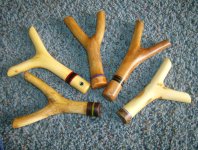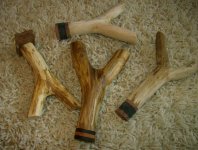-
Happy Wright Brothers Day (1903)! 🐱🦅🛩️
You are using an out of date browser. It may not display this or other websites correctly.
You should upgrade or use an alternative browser.
You should upgrade or use an alternative browser.
G
Guest
Guest
Most impressive. Not least of which is the patience to see it through from beginning to end.
You can’t rush nature and I don’t have a DIY home method to speed the drying process without potentially splitting or checking the wood.
The latter would be nice; Antler was the last workable piece I have finished drying and I have nothing in the wings except the three water-gorged saplings I dug up in November. Patience is wanting to work on another piece now and having to wait for a few years.
Antler was the 25[SUP]th[/SUP] pipe I’ve made, and the 24[SUP]th[/SUP] I’ve given away. There were only two people in the random draw for a new pipe and Muskrat came in second.
DougD needed a pipe for his new shop and even won the debate with the missus, who wanted to display it unused as a object d’art in the house.
Wow. Finished up that's the wildest looking pipe I've seen. I'm honored that I was even in the running. I guess I'll just have to wait seven years or so. You probably don't want me owning one of those beauties anyway. My pipes have a habit of befalling some rather gruesome deaths. There is an ongoing joke at the tobacco shop whenever I go in for a new one, where they are trying to get me to switch to corncobs.
G
Guest
Guest
Stick & Stone update
I harvested three more sticks with grown-in semi precious stones. Two of these were implanted with huge 1 11/16 x 1 inch cowboy belt buckle cabochons, far larger stones than I use in walking stick sized trees, so the trees were of necessity far more stout.
The actual harvesting was comical. And tiring. These were deep in the swamp, and the roads were still washed out from Matthew. It was a long hike and I brought a backpack to haul the saws and shovels and such.
First harvest, a Sweet Bay (Swamp Magnolia). Good gugga mugga, that thing had a massive double tap root. I dug out a meteor impact sized crate around the roots with the too small shovel I had chosen, cursing that shovel selection with ever winky bladeful.
And then spent an exhausting hour trying to cut through the massive tap roots deep in the hole with the too dull saws I had selected. Serious lack of planning and forethought there.
Greater gugga mugga, that thing, even cut at 3 feet tall for some kind of sculpture carving (I’m thinking massive candle stick holder) was heavy as hell, a good 30 lbs. (It is already, two weeks later, considerably lighter).
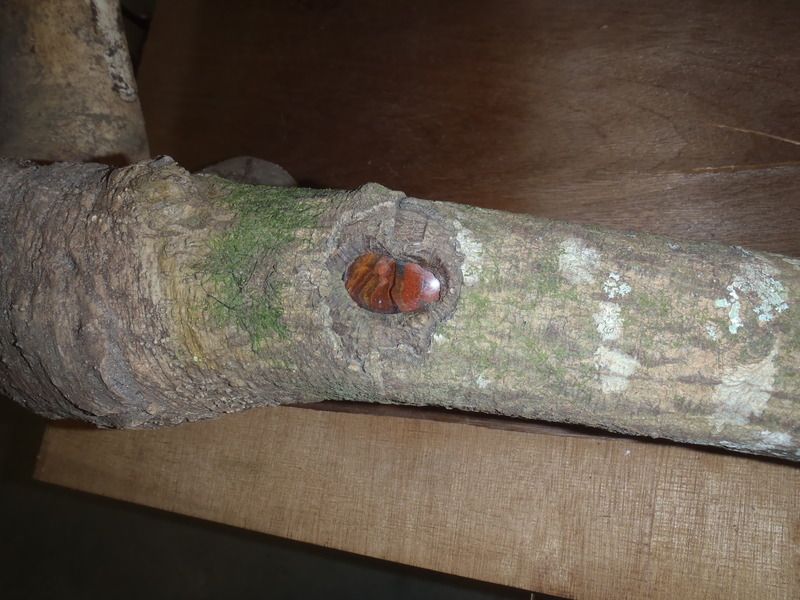
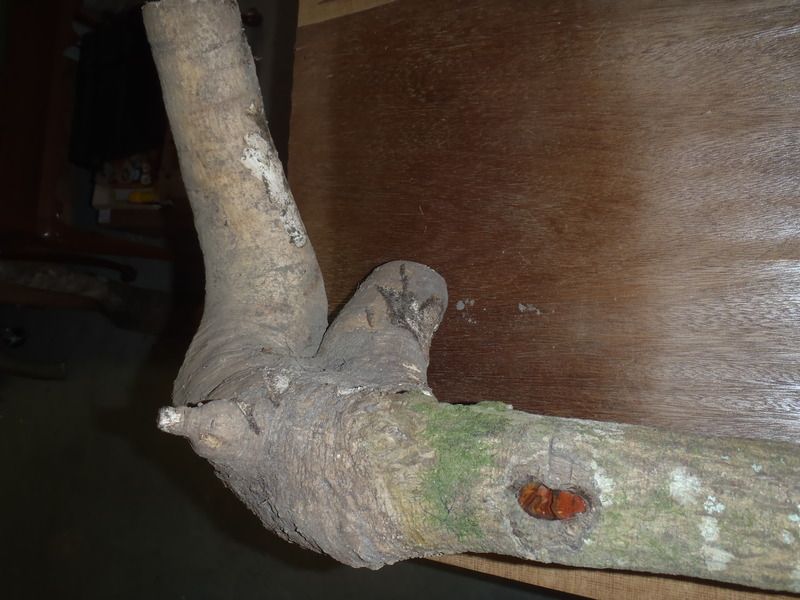
Having a backpack full of too dull and wimpy tools and a 30 lb log to tote out of the forest I decided to hike back with el massivo and return with better saws and shovels.
Out and back, that’s now three trips into the swamp, and one hike out still to go.
Second harvest was a holly, again with a cowboy belt buckle stone. Good gugga mugga #3, that one had a root ball the size of two cinder blocks, starting immediately underground and spreading in every direction. I would have needed a backhoe to dig the hole and a Stihl with a 30 inch bar to cut the root ball. I was forced to cut in at ground level a few inches below the stone. That one may become a pipe or gear shift knob.
Fearing that close to the stone cut end would crack/check badly while drying I tightened a hose clamp around the end and sealed the exposed butt end with G/flex a few days later*
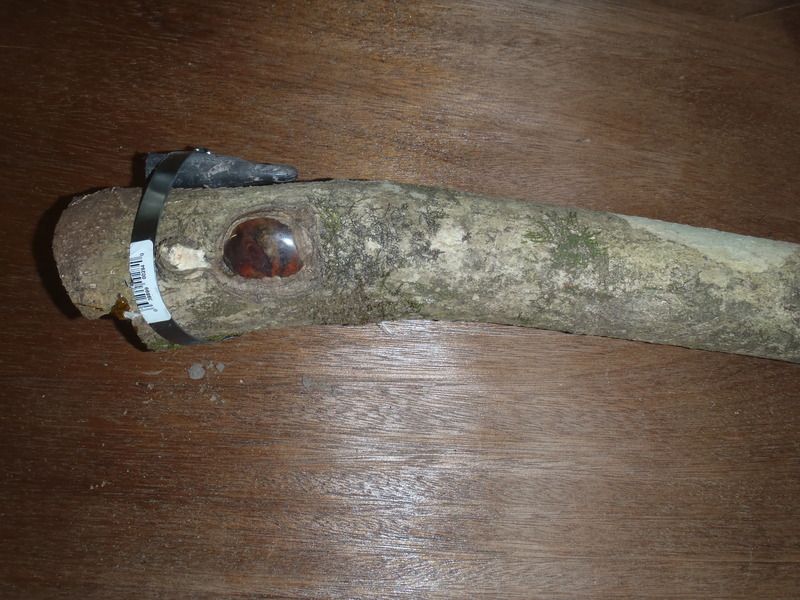
I had my fingers crossed for third harvest, friend Willie’s stick. Good gugga mugga #4, I shoulda made him dig up his own dang stick. Another giant hole dug, another massive root ball (maybe that’s a swamp thing) to saw through, and once again heavy as hell.
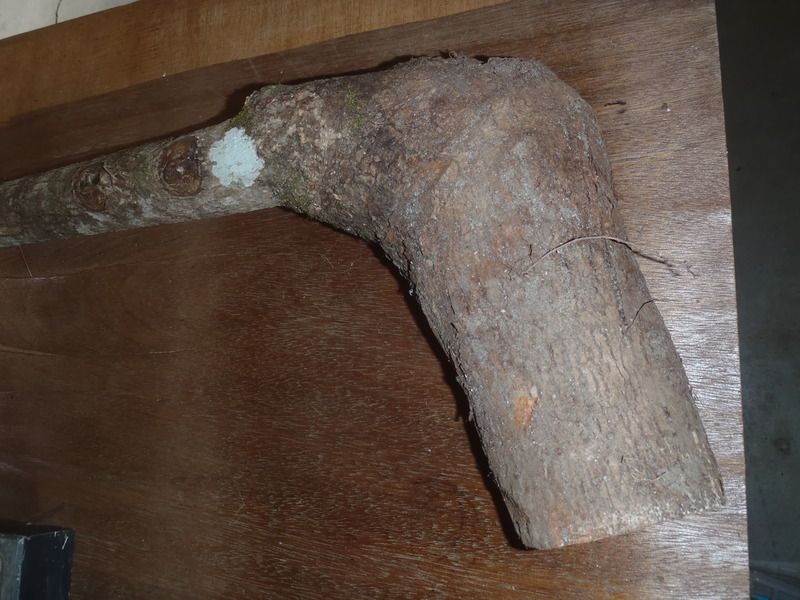
That one, with more normal sized cabochons, had fully overgrown one of the two stones in a scant 2 years time (implanted March 10, 2015). That stone will need to be carefully excavated in 3 or 4 years when the waterlogged stick has dried. I guess in 2021 I’ll do that careful carve out for Willie and he can take it from there.

I cut Willie’s at (over) cane sized; 40 inches long. That massive right angle root ball would make a helluva shillelagh handle with a lot of carving reduction.
*Bring this into the boat work realm, I had left a tiny bit of G/flex at Cooterville years ago, maybe a combined thimbleful once mixed. The hardener had turned a dark brown, almost black. It still set up fine, although it dried very dark.
Hey Muskrat, you are still in the running. One of last year’s harvested pieces will probably be a Canoe Tripping raffle item next year.
I harvested three more sticks with grown-in semi precious stones. Two of these were implanted with huge 1 11/16 x 1 inch cowboy belt buckle cabochons, far larger stones than I use in walking stick sized trees, so the trees were of necessity far more stout.
The actual harvesting was comical. And tiring. These were deep in the swamp, and the roads were still washed out from Matthew. It was a long hike and I brought a backpack to haul the saws and shovels and such.
First harvest, a Sweet Bay (Swamp Magnolia). Good gugga mugga, that thing had a massive double tap root. I dug out a meteor impact sized crate around the roots with the too small shovel I had chosen, cursing that shovel selection with ever winky bladeful.
And then spent an exhausting hour trying to cut through the massive tap roots deep in the hole with the too dull saws I had selected. Serious lack of planning and forethought there.
Greater gugga mugga, that thing, even cut at 3 feet tall for some kind of sculpture carving (I’m thinking massive candle stick holder) was heavy as hell, a good 30 lbs. (It is already, two weeks later, considerably lighter).


Having a backpack full of too dull and wimpy tools and a 30 lb log to tote out of the forest I decided to hike back with el massivo and return with better saws and shovels.
Out and back, that’s now three trips into the swamp, and one hike out still to go.
Second harvest was a holly, again with a cowboy belt buckle stone. Good gugga mugga #3, that one had a root ball the size of two cinder blocks, starting immediately underground and spreading in every direction. I would have needed a backhoe to dig the hole and a Stihl with a 30 inch bar to cut the root ball. I was forced to cut in at ground level a few inches below the stone. That one may become a pipe or gear shift knob.
Fearing that close to the stone cut end would crack/check badly while drying I tightened a hose clamp around the end and sealed the exposed butt end with G/flex a few days later*

I had my fingers crossed for third harvest, friend Willie’s stick. Good gugga mugga #4, I shoulda made him dig up his own dang stick. Another giant hole dug, another massive root ball (maybe that’s a swamp thing) to saw through, and once again heavy as hell.

That one, with more normal sized cabochons, had fully overgrown one of the two stones in a scant 2 years time (implanted March 10, 2015). That stone will need to be carefully excavated in 3 or 4 years when the waterlogged stick has dried. I guess in 2021 I’ll do that careful carve out for Willie and he can take it from there.

I cut Willie’s at (over) cane sized; 40 inches long. That massive right angle root ball would make a helluva shillelagh handle with a lot of carving reduction.
*Bring this into the boat work realm, I had left a tiny bit of G/flex at Cooterville years ago, maybe a combined thimbleful once mixed. The hardener had turned a dark brown, almost black. It still set up fine, although it dried very dark.
Hey Muskrat, you are still in the running. One of last year’s harvested pieces will probably be a Canoe Tripping raffle item next year.
No Title
Mike, that's some cool stuff. I have been making and shooting slingshot for the last few years and just had to share your idea with my friends on a slingshot forum. It may not work so well with small forks but I know for sure they'll appreciate your ingenuity!! The stones would sure look sharp in these! I'll be looking forward to more of your work!!
Mike, that's some cool stuff. I have been making and shooting slingshot for the last few years and just had to share your idea with my friends on a slingshot forum. It may not work so well with small forks but I know for sure they'll appreciate your ingenuity!! The stones would sure look sharp in these! I'll be looking forward to more of your work!!
Attachments
I own 4 levels, two hammers, four tape measures, 2 sets of micro screw drivers and countless other carpentry, plumbing, electrical hand tools all (nearly) neatly put away in (forgotten) various handy places in workshed and home. How in the hell do you remember where you've stashed these stone projects deep in the backwoods? I reckon in 60 years time someone will be clearing that acreage for a housing development, and wonder at a smooth and shiny pebble embedded in a gnarly old branch. And maybe that someone'll be one of your grandchildren, who'll recognize that artistic marriage of wood and stone as "one that got away."
Nice stuff d-s-i-l!! My grade 4 teacher's desk didn't have nearly as nice a collection as that.
That smoothness and form reminds me of antler. Cool.
ps I've never understood any attraction to the sheleighly; until I found one on a job, safely stored and forgotten on the top of a wardrobe. Turned out to be an heirloom from Ireland, generations old. It was well worn and comfortable in the hand. It felt good to hold, and I wondered at the history it might carry. The knobby end looked brutally capable.
Nice stuff d-s-i-l!! My grade 4 teacher's desk didn't have nearly as nice a collection as that.
That smoothness and form reminds me of antler. Cool.
ps I've never understood any attraction to the sheleighly; until I found one on a job, safely stored and forgotten on the top of a wardrobe. Turned out to be an heirloom from Ireland, generations old. It was well worn and comfortable in the hand. It felt good to hold, and I wondered at the history it might carry. The knobby end looked brutally capable.
Last edited:
G
Guest
Guest
How in the hell do you remember where you've stashed these stone projects deep in the backwoods? I reckon in 60 years time someone will be clearing that acreage for a housing development, and wonder at a smooth and shiny pebble embedded in a gnarly old branch.
I don’t know. I make a (very) crude map in my record book when I select a sapling, sketching out a “six paces north of the big bifurcated oak, 10 paces west” kinda thing, but having spent a lifetime wandering off trail I can usually walk right to them without map consultation.
That has involved a lot of small trees in remote off-trail places since May of ’75 (Cherry, 3 bombay agates, 43 months growing time to harvest) and I haven’t lost one yet. It does get harder if I wait too long after the hose clamps come off and the tree grows completely over the cabochon, leaving just a wee pucker to discover.
I think I actually recognize the individual sapling; I have spent time up close and person with it, laying on the ground drilling and chiseling holes and attaching hose clamps, and usually re-visiting it once a year or so. And performing odd rituals.
Not dancing naked around it, uttering mysterious incantations (only a few times, until a young woman hiking off trail caught me). I would collect things I found on forest walks, owl and hawk pellets, fox scat, deer hair, feathers, bone and shell fragments and such, and grind them into a powder at home to later sprinkle in the earth at the base of the tree. Yeah, some little parts of me in there as well, fingernail clippings and beard trimmings mostly.
A lot of the stick and stone stuff has molecules of sundry forest critters, and me, fertilized within. That is noted in the record book, including when and with what it was “ritualized”.
“Owl pellets, fish scales, mortar from grandpa’s lodge on Lake Champlain, scabs and skin”? I must have gone north that summer, and been both sunburned and clumsy.
ps I've never understood any attraction to the sheleighly; until I found one on a job, safely stored and forgotten on the top of a wardrobe. Turned out to be an heirloom from Ireland, generations old. It was well worn and comfortable in the hand. It felt good to hold, and I wondered at the history it might carry. The knobby end looked brutally capable.
I am not a fan of the cane, at least not yet. I much prefer a full sized hiking staff, at least 5 feet tall, for a variety of reasons, including stream crossings and the ability to poke or prod things at some safe distance.
But, while I don’t covet many things in life, my great-grandfather’s old country shillelagh is one of them. An uncle owns it, somehow still, after two houses have burned down. I guess know what he runs into fire to save.
That thing is awesome, black with age or patina or type of wood, with a face carved at the front of the handle and smaller faces on limb knobs and burls along the shaft, shod with an iron spike. I wouldn’t want to get hit by it, and am sure it has tales to tell if it could.
It is way too short for me; great grandpaw needed more than a potato based diet and had to emigrate. I gave that uncle a companion cane, inset with turquoise, moss agate, jade and sardonyx. All of my uncles have one actually.
Dammit, I really want to pull out one of the pieces I harvested in November of 2015, but I know they are not dry enough yet.
G
Guest
Guest
Stick and Stone Candlesticks
I had a couple pieces of stone embedded sapling finally dried and ready to finish, one Holly and one Swamp Magnolia. Growth embedded with large semi-precious stones (1 1/8” x 7/8” ovals) from cowboy belt buckles), they needed a thicker than usual sapling.
After drying for a few years they were still massive, and heavy, but bark on both pieces was tight and intact, and instead of removing it and sanding the pieces smooth I left them rustic, to better show how the stone was grown in place.
Exposed tops and bottoms sanded smooth and seal coated with epoxy, with a spade bit inset sized to hold a tea candle.
 PC251459 by Mike McCrea, on Flickr
PC251459 by Mike McCrea, on Flickr
Easy to “finish” without stripping bark and sanding smooth, and quick if discounting the growing time and drying time. They made nice Christmas gifts, wrapped with a printed history of the sapling location and growth, implant and harvest dates, and some natural history information of each type of wood.
“Swamp Magnolia” is Magnolia virginiana, also known as Virginia Magnolia, Sweet Bay, Swamp Bay, White Bay, Beaver Tree and a dozen other colloquial names depending on where you are in the south.
https://homeguides.sfgate.com/unique-sweetbay-magnolia-31872.html
I had a couple pieces of stone embedded sapling finally dried and ready to finish, one Holly and one Swamp Magnolia. Growth embedded with large semi-precious stones (1 1/8” x 7/8” ovals) from cowboy belt buckles), they needed a thicker than usual sapling.
After drying for a few years they were still massive, and heavy, but bark on both pieces was tight and intact, and instead of removing it and sanding the pieces smooth I left them rustic, to better show how the stone was grown in place.
Exposed tops and bottoms sanded smooth and seal coated with epoxy, with a spade bit inset sized to hold a tea candle.
 PC251459 by Mike McCrea, on Flickr
PC251459 by Mike McCrea, on FlickrEasy to “finish” without stripping bark and sanding smooth, and quick if discounting the growing time and drying time. They made nice Christmas gifts, wrapped with a printed history of the sapling location and growth, implant and harvest dates, and some natural history information of each type of wood.
“Swamp Magnolia” is Magnolia virginiana, also known as Virginia Magnolia, Sweet Bay, Swamp Bay, White Bay, Beaver Tree and a dozen other colloquial names depending on where you are in the south.
https://homeguides.sfgate.com/unique-sweetbay-magnolia-31872.html
G
Guest
Guest
Couple more stick and stone pieces.
I want to make a present for a young friend’s wedding; thirty some years young and I have known him since preemie Day 1. Interesting, well informed guy, and a raised-in-a-canoe wonderful companion at any age. A blender or crock pot won’t cut it.
I have choices of two dried and ready to work stone embedded wood pieces, both too awkward or messed up to become walking sticks. And intentions to make a ceremonial wedding pipe from one, and a simple bark-on candle stick holder from the other.
“Trail #1” is a moss agate cabochon embedded in a Holly. A huge moss agate cabochon, 1 ¾” x 1” oval, another semi-precious salvage from a cowboy belt buckle.
It was a kinda effed up piece from the sapling start, using a huge cabochon meant selecting a much stouter than usual sapling, near 3” diameter. Kinda effed up at the take down too; I knew I might not be back in time, so I harvested it a year prematurely, before it was evenly bezel-grown on all sides of the stone. Still well embedded, just a bit sloppy off-oval.
Effed up on harvest as well. It had a (typical) swamp-style root ball far too massive to dig up, so I cut it off at ground level and 3 feet up the trunk. Kind of short featureless looking piece of wood, but it should have a pipe in it somewhere.
On to saws, rasps, files, sanders and shaping. Freaking Holly is some tough wood to work, I nearly came down with Coping Saw Elbow-its cutting out some needed decorative swoops and curves. Even an 80 grit belt sander was slow going.
As a wood Holly is pale blah, without much visible grain pattern, even with some curves and swoops cut out and sanded smooth. Too pale blah, some Rosewood stain darkened it agreeably.
First coat of oil and the slight grain pattern is beginning to show, another 3 or 4 coats and it should have some deeper luster.
 P6200003 by Mike McCrea, on Flickr
P6200003 by Mike McCrea, on Flickr
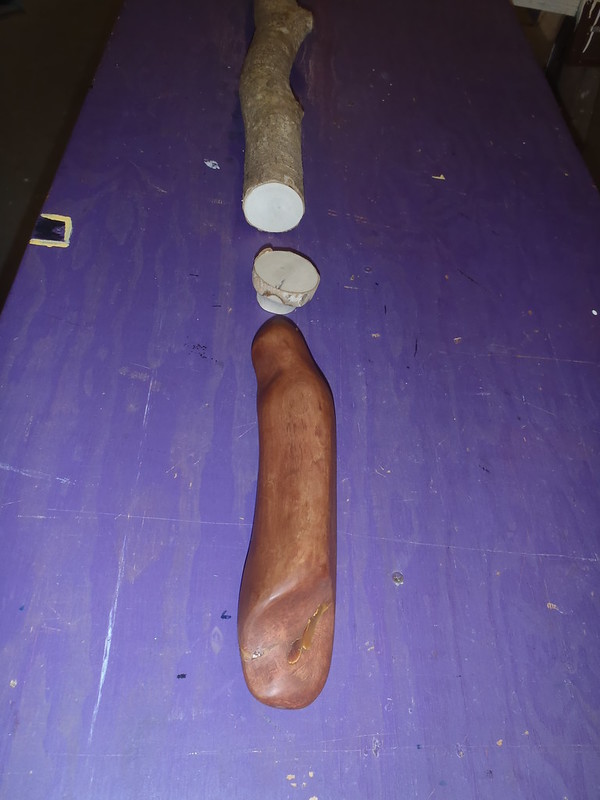 P6200005 by Mike McCrea, on Flickr
P6200005 by Mike McCrea, on Flickr
Four coats of oil on the ceremonial pipe and it’s starting to glow. It is still a bit plain for a ceremonial pipe, and needs a bit of flourish. “Ugh, me trade you pipe with beads for woman!”
 P6290026 by Mike McCrea, on Flickr
P6290026 by Mike McCrea, on Flickr
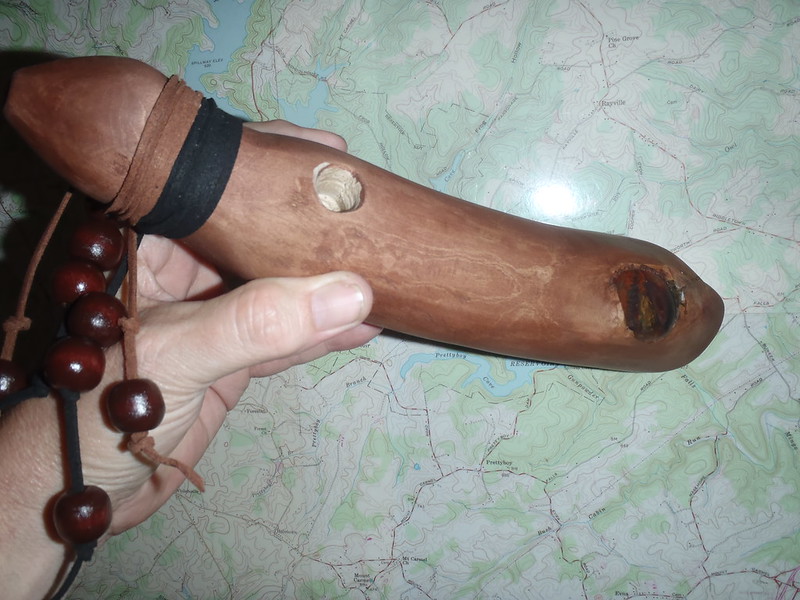 P6290029 by Mike McCrea, on Flickr
P6290029 by Mike McCrea, on Flickr
The ) ( carved indentation at the end was of deliberate design. Indent wrapped securely with leather and a few starter beads; he can stick on additional trinkets and feathers of his own choosing. I’m partial to the curl feathers on a Mallard.
http://goodhunt.blogs.theledger.com/19069/about-a-mallards-curls/
Or, as a conversation piece, road kill raccoon baculum bones, quite the wedding night totem.
I want to make a present for a young friend’s wedding; thirty some years young and I have known him since preemie Day 1. Interesting, well informed guy, and a raised-in-a-canoe wonderful companion at any age. A blender or crock pot won’t cut it.
I have choices of two dried and ready to work stone embedded wood pieces, both too awkward or messed up to become walking sticks. And intentions to make a ceremonial wedding pipe from one, and a simple bark-on candle stick holder from the other.
“Trail #1” is a moss agate cabochon embedded in a Holly. A huge moss agate cabochon, 1 ¾” x 1” oval, another semi-precious salvage from a cowboy belt buckle.
It was a kinda effed up piece from the sapling start, using a huge cabochon meant selecting a much stouter than usual sapling, near 3” diameter. Kinda effed up at the take down too; I knew I might not be back in time, so I harvested it a year prematurely, before it was evenly bezel-grown on all sides of the stone. Still well embedded, just a bit sloppy off-oval.
Effed up on harvest as well. It had a (typical) swamp-style root ball far too massive to dig up, so I cut it off at ground level and 3 feet up the trunk. Kind of short featureless looking piece of wood, but it should have a pipe in it somewhere.
On to saws, rasps, files, sanders and shaping. Freaking Holly is some tough wood to work, I nearly came down with Coping Saw Elbow-its cutting out some needed decorative swoops and curves. Even an 80 grit belt sander was slow going.
As a wood Holly is pale blah, without much visible grain pattern, even with some curves and swoops cut out and sanded smooth. Too pale blah, some Rosewood stain darkened it agreeably.
First coat of oil and the slight grain pattern is beginning to show, another 3 or 4 coats and it should have some deeper luster.
 P6200003 by Mike McCrea, on Flickr
P6200003 by Mike McCrea, on Flickr P6200005 by Mike McCrea, on Flickr
P6200005 by Mike McCrea, on FlickrFour coats of oil on the ceremonial pipe and it’s starting to glow. It is still a bit plain for a ceremonial pipe, and needs a bit of flourish. “Ugh, me trade you pipe with beads for woman!”
 P6290026 by Mike McCrea, on Flickr
P6290026 by Mike McCrea, on Flickr P6290029 by Mike McCrea, on Flickr
P6290029 by Mike McCrea, on FlickrThe ) ( carved indentation at the end was of deliberate design. Indent wrapped securely with leather and a few starter beads; he can stick on additional trinkets and feathers of his own choosing. I’m partial to the curl feathers on a Mallard.
http://goodhunt.blogs.theledger.com/19069/about-a-mallards-curls/
Or, as a conversation piece, road kill raccoon baculum bones, quite the wedding night totem.
G
Guest
Guest
The bark-on candlestick is cakewalk construction compared to sawing, rasping, filing and sanding a fully finished piece. And I like how the bark-on better shows that the stones were grown into the tree.
Pond #3 on my records is another tight barked Sweetbay/Swamp Magnolia, inset with an oval Botswana agate and an oval Picture Jasper.
 P6300030 by Mike McCrea, on Flickr
P6300030 by Mike McCrea, on Flickr
 P6300031 by Mike McCrea, on Flickr
P6300031 by Mike McCrea, on Flickr
Four+ years drying in a 50% max humidity room and it should withstand cutting the ends, sanding flush and flat, and using a spade bit to add a leveled tee candle recess on top, hopefully without splitting or checking that butt end.
To be on the safe side I drilled the tee candle recess a bit wide, and coated both cut butt ends with G/flex, which seems to preclude any future checking or splitting.
 P6300036 by Mike McCrea, on Flickr
P6300036 by Mike McCrea, on Flickr
One piece or the other; I’ll have to ask his fiancé to register.
Pond #3 on my records is another tight barked Sweetbay/Swamp Magnolia, inset with an oval Botswana agate and an oval Picture Jasper.
 P6300030 by Mike McCrea, on Flickr
P6300030 by Mike McCrea, on Flickr P6300031 by Mike McCrea, on Flickr
P6300031 by Mike McCrea, on FlickrFour+ years drying in a 50% max humidity room and it should withstand cutting the ends, sanding flush and flat, and using a spade bit to add a leveled tee candle recess on top, hopefully without splitting or checking that butt end.
To be on the safe side I drilled the tee candle recess a bit wide, and coated both cut butt ends with G/flex, which seems to preclude any future checking or splitting.
 P6300036 by Mike McCrea, on Flickr
P6300036 by Mike McCrea, on FlickrOne piece or the other; I’ll have to ask his fiancé to register.
G
Guest
Guest
Jeeze, my stock of harvested stick & stone pieces is getting mighty low. I am down to two dried pieces left, both swamp saplings. Massive/awkward “Pond #2” in my records.
 P6300038 by Mike McCrea, on Flickr
P6300038 by Mike McCrea, on Flickr
See what I mean about a swamp-typical root ball? Like a freaking cinder block on one end.
Oy vey that piece will be a lot of work; it grew so fast (a single very wet season) that the top stone, briefly unattended, was forced sideways, and the bottom stone is completely overgrown and will need to be (very carefully) excavated to show.
 P6300039 by Mike McCrea, on Flickr
P6300039 by Mike McCrea, on Flickr
The other ready to work dried piece has the makings of a walking stick, “Trail #2”, but it is again Holly, and even 5 years dried is still heavy as hell. With bark and root structure intact it is 4 ½ lbs at walking stick height, which would still be a couple pounds once shaved and carved. That would be a full body hiking workout.
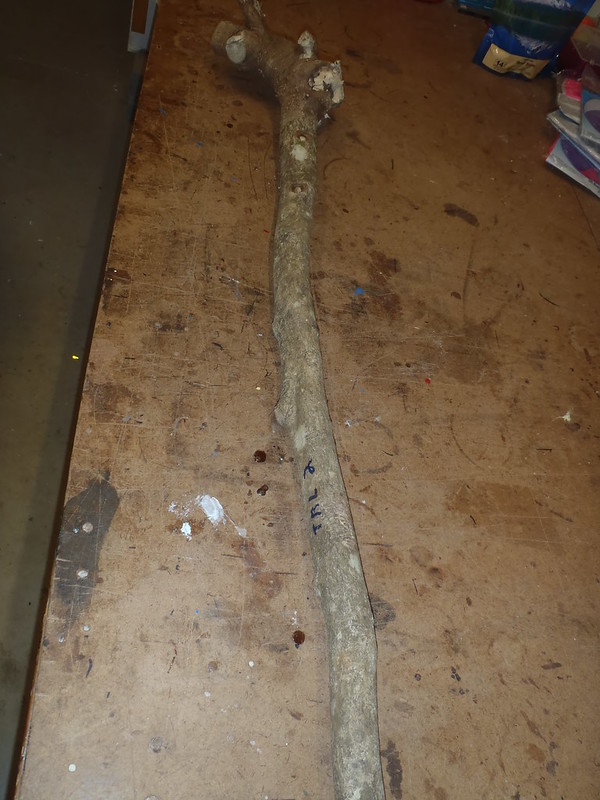 P6300041 by Mike McCrea, on Flickr
P6300041 by Mike McCrea, on Flickr
There are a few knots and limb burls along the length; I’m thinking a traditional knob-headed Shillelagh.
Good summertime now-and-then shop project when it’s 95F and 90% humidity outside.
 P6300042 by Mike McCrea, on Flickr
P6300042 by Mike McCrea, on Flickr
I need to cabochon-embed another stock of saplings. Soon; growing locally hidden back in the woods they’ll be sufficiently bezeled in 3 to 5 years, and dry enough to work in another 3 – 5.
 P6300038 by Mike McCrea, on Flickr
P6300038 by Mike McCrea, on FlickrSee what I mean about a swamp-typical root ball? Like a freaking cinder block on one end.
Oy vey that piece will be a lot of work; it grew so fast (a single very wet season) that the top stone, briefly unattended, was forced sideways, and the bottom stone is completely overgrown and will need to be (very carefully) excavated to show.
 P6300039 by Mike McCrea, on Flickr
P6300039 by Mike McCrea, on FlickrThe other ready to work dried piece has the makings of a walking stick, “Trail #2”, but it is again Holly, and even 5 years dried is still heavy as hell. With bark and root structure intact it is 4 ½ lbs at walking stick height, which would still be a couple pounds once shaved and carved. That would be a full body hiking workout.
 P6300041 by Mike McCrea, on Flickr
P6300041 by Mike McCrea, on FlickrThere are a few knots and limb burls along the length; I’m thinking a traditional knob-headed Shillelagh.
Good summertime now-and-then shop project when it’s 95F and 90% humidity outside.
 P6300042 by Mike McCrea, on Flickr
P6300042 by Mike McCrea, on FlickrI need to cabochon-embed another stock of saplings. Soon; growing locally hidden back in the woods they’ll be sufficiently bezeled in 3 to 5 years, and dry enough to work in another 3 – 5.
G
Guest
Guest
I’ve bought most of the semi-precious stones at rock shops out west. The proprietors of those shops, often found as a remote outpost along the blue highways back roads, just west of where Jesus lost his sandal, are usually interesting characters in their own right. Chat up that 80 year old geologist and sip his offer of bad coffee, he knows every nook and cranny of the area.
Those crusty old geologist rock shop proprietors are a dying breed. It was probably the gawd awful excuse for coffee that killed them off.
While I’d prefer a sit-a-spell with a crusty old geologist that breed have become unicorns, and I needed a fresh stock of semi-precious cabochons. Maybe it wasn’t the bad coffee, maybe Amazon killed the old rock shop guys.
I got stones. Always wanted to say that.
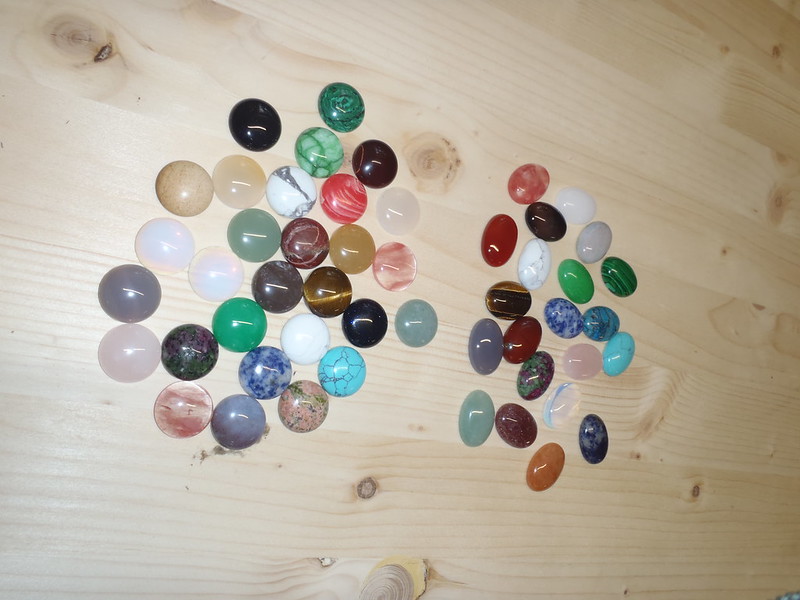 P7040002 by Mike McCrea, on Flickr
P7040002 by Mike McCrea, on Flickr¾” round cabs and 5/8 x 7/8 oval cabs. The round ones are dead simple to implant in a sapling; ¾” spade bit, battery op drill & screwdriver to tighten the hose clamp, no chiseling a precise oval shape into the bark.
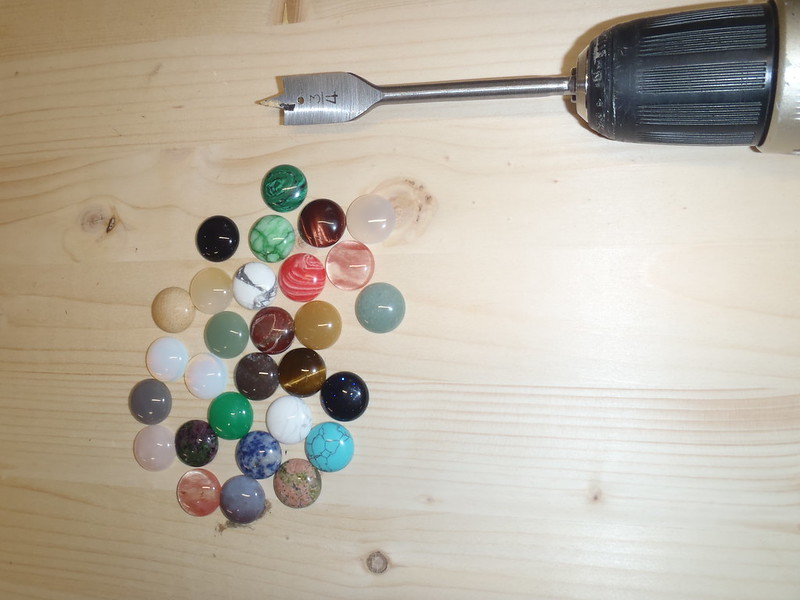 P7040004 by Mike McCrea, on Flickr
P7040004 by Mike McCrea, on FlickrHose clamps to gently tighten around the sapling, keeping the cabochon held firmly in place, little rubber cork to lift the hose clamp off the growing bezel area. Easy peeze.
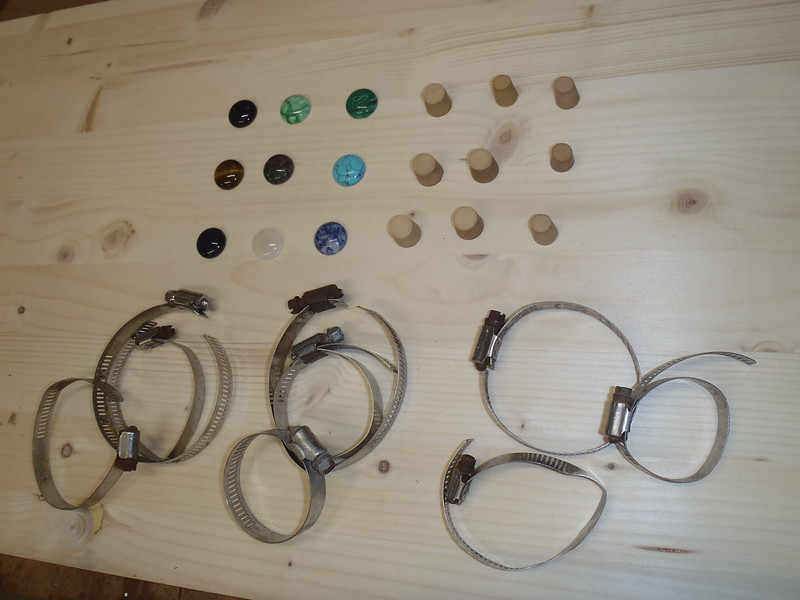 P7040005 by Mike McCrea, on Flickr
P7040005 by Mike McCrea, on FlickrSpray paint the hose clamps un-shiny green if implanted somewhere off property.
Similar threads
- Replies
- 4
- Views
- 927
G
- Replies
- 14
- Views
- 2K

